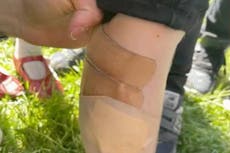Lawmaker introduces rabies bill after rabid fox bites his leg
‘For too many Americans, the costs of treatment would break their banks,’ said Rep Ami Bera


A California lawmaker who was bit by a fox is hoping to use his medical scare to get legislation passed that would bring down the cost of the life-saving rabies vaccine.
Rep Ami Bera, a physician who represents California’s 7th District, said while introducing the legislation on Wednesday – timed to align with World Rabies Day – that he only became aware of the high cost of the rabies treatment after he was wounded by a fox while walking on Capitol Hill.
“Despite being a fatal disease, rabies is preventable if treated quickly,” the California Democrat said in a statement Wednesday.
“After being bit by a rabid fox, I was fortunate to have access to readily available and low-cost vaccines. But for too many Americans, the costs of treatment would break their banks.”
Mr Bera, like others who are harmed by a wild animal, was treated with both a regimen of rabies shots and immunoglobulin. While most patients will go through a series of shots to treat the possible onset of the disease, immunoglobulin is only delivered once at the first appointment, as it serves as a temporary layover to kick the immune system into overdrive until the rabies medication begins taking effect.
The wild animal that bit Mr Bera back in April was first mistaken by the lawmaker as a small dog. It wasn’t until he turned around that he realised that it was a potentially rabid fox that had latched onto his back leg.
He was able to keep the animal from doing further harm to his body by using his umbrella as a makeshift weapon that he successfully used to shove the animal off.
A fox was later caught on the Capitol grounds after there had been several reported sightings of one prowling the area, and at least a couple others reporting that they too had been bit, The Washington Post reported.
While it’s unclear whether the captured fox was the same as the one that attacked the Democratic congressman, Mr Bera says that the incident has brought to light an issue he realises now is impacting more Americans than most likely assume.
“For uninsured Americans, costs for these life-saving vaccines could reach upwards of $7k. This is unacceptable,” tweeted the California congressman when introducing the Affordable Rabies Treatment for Uninsured Act on Wednesday.
Based on estimates from the Centers for Diseases and Control and Prevention, each year approximately 60,000 Americans will receive post exposure prophylaxis (PEP), which on the first day consists of one immunoglobulin dose and one rabies vaccine and is then followed up with three shots of the rabies medication on days 3, 7 and 14.
While the congressman said in his statement introducing the bill that costs for patients for the life-savings vaccine can range from $1,200 to $6,500, a Vox investigation from 2018 found that the entire invoice from a person’s trip to the emergency room – including the vaccines – can actually top out at closer to $10,000.
That investigation found that the problem of the high costs for patients arises from two factors. The first one being that the life-saving treatment itself is among the most expensive in the developed world.
According to the British National Formulary, one vial of rabies immunoglobulin costs £600, or $813, in the UK. With most adult-sized men requiring two vials, the total cost of the initial treatment would be $1,626, which is both a fraction of what American pharmaceuticals charge and is, importantly, covered for all patients through the country’s universal healthcare.
The second factor that brings the price of treating rabies up is the fact that it is most commonly administered in emergency rooms, as, according to data from Amino, that’s where 95 percent of post-exposure rabies treatment happens because that’s where most of the vials are stored.
Facility fees at emergency rooms, the flat rate that patients are normally charged just when they walk through the doors of a facility, can start at just a couple hundred dollars.
And since the treatment schedule for rabies requires multiple visits for each round of shots, patients are stepping across the threshold of the ER at least four times, each time racking up more and more “facility fees” since most primary care doctors wouldn’t have the drugs on their shelf.
For Mr Bera’s bill, it would allow for program-registered providers to submit claims to the secretary of Health and Human Services, which would then pay back providers who are providing the PEP services to uninsured patients.
“My legislation would seek to reduce the high costs of treatment for uninsured Americans, ensuring that no one has to choose between receiving treatment or not because of high costs,” Mr Bera said. “I encourage all Americans to remain vigilant around wild animals and to seek medical attention if bitten or scratched. Costs should never be a barrier for individuals seeking life-saving treatment.”
Join our commenting forum
Join thought-provoking conversations, follow other Independent readers and see their replies
Comments


Bookmark popover
Removed from bookmarks